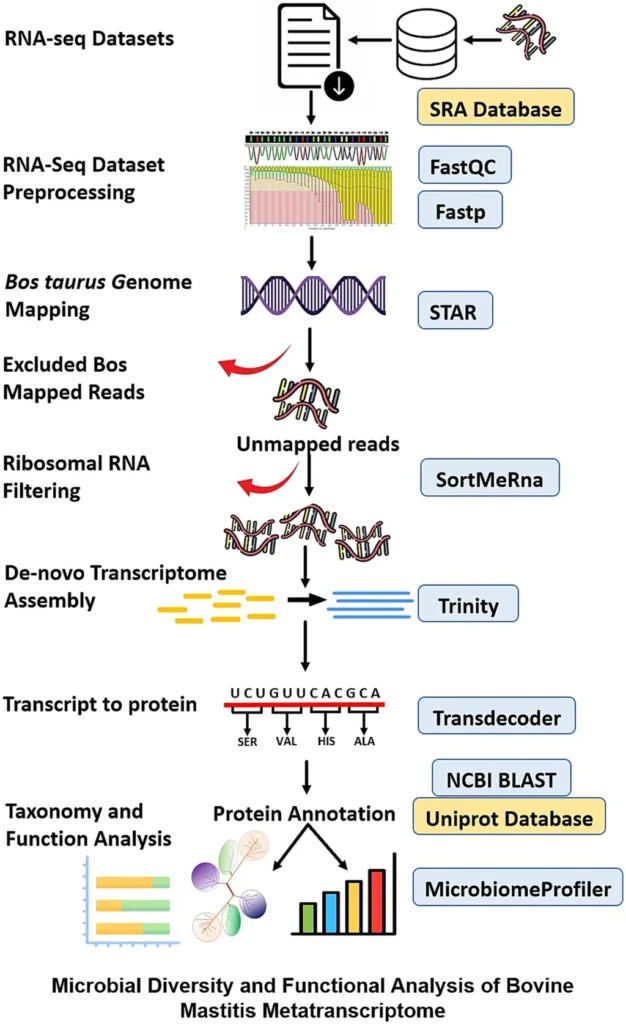In the heart of Egypt’s dairy industry, a silent battle rages within the udders of cows, threatening milk production and economic stability. Bovine mastitis, a prevalent disease, has long been a thorn in the side of farmers, causing significant economic losses. However, a recent study published in ‘Slovenian Veterinary Research’ by lead author Sahar O. Ahmed from the Mycoplasma Department at the Animal Health Research Institute (AHRI), Agricultural Research Center (ARC), Egypt, sheds new light on the molecular characterization of bacterial pathogens causing this debilitating condition, with a special focus on Mycoplasma bovis.
The study, conducted on 370 milk samples from dairy farms in Fayoum governorate, revealed a high prevalence of mastitis, with 8.91% of samples testing positive for the California mastitis test (CMT). The results, obtained through multiplex RT-PCR, showed that Escherichia (E.) coli was the most predominant pathogen (84.8%), followed by Staphylococcus (S.) aureus (81.8%), while Mycoplasma (M.) bovis was the least prevalent (51.5%). However, mixed infections with two or more bacterial agents were also identified, with combinations of E. coli, S. aureus, Streptococcus spp., and M. bovis being the most common.
The sequence analysis of M. bovis 16SrRNA genes showed a high similarity of examined isolates to strains previously deposited in the GenBank, recovered from the same locality. The gyrA amino acids showed no substitution but showed 100% similarity with M. bovis isolates worldwide. However, the amino acid sequence of parC showed substitution at positions 2 (Gln to Arg), 75 (Ile to Ser), and 79 (Asn to Asp).
“These findings are crucial for the development of appropriate treatment and control measures for M. bovis,” said lead author Sahar O. Ahmed. “The sequence results can help us understand the genetic makeup of these pathogens, enabling us to develop more targeted and effective treatments.”
The study also highlights the potential of multiplex RT-PCR as a standard diagnostic method for major mastitis pathogens. This could revolutionize the way farmers and veterinarians diagnose and treat mastitis, leading to improved milk production and economic gains for the agriculture sector.
The commercial impacts of this research are significant. Mastitis is a major cause of economic loss in the dairy industry, with estimates suggesting that it costs the global dairy industry billions of dollars annually. By understanding the molecular characterization of the pathogens causing mastitis, farmers and veterinarians can develop more effective treatment and prevention strategies, leading to improved milk production and economic gains.
Moreover, the use of multiplex RT-PCR as a diagnostic tool could lead to faster and more accurate diagnosis of mastitis, enabling farmers to take swift action to treat affected cows and prevent the spread of the disease. This could lead to a significant reduction in the economic losses associated with mastitis, benefiting both farmers and the wider agriculture sector.
The research also opens up new avenues for future developments in the field. The sequence results can be used to develop vaccines and other treatments targeted at specific genetic markers of the pathogens. This could lead to more effective and sustainable control of mastitis, reducing the need for antibiotics and other treatments that can have negative environmental and health impacts.
In conclusion, this study provides valuable insights into the molecular characterization of bacterial pathogens causing bovine mastitis, with a special focus on Mycoplasma bovis. The findings have significant commercial impacts for the agriculture sector, paving the way for more effective treatment and prevention strategies, and opening up new avenues for future research and development. As lead author Sahar O. Ahmed puts it, “This is just the beginning. There is still much to learn and discover in the fight against bovine mastitis.”

